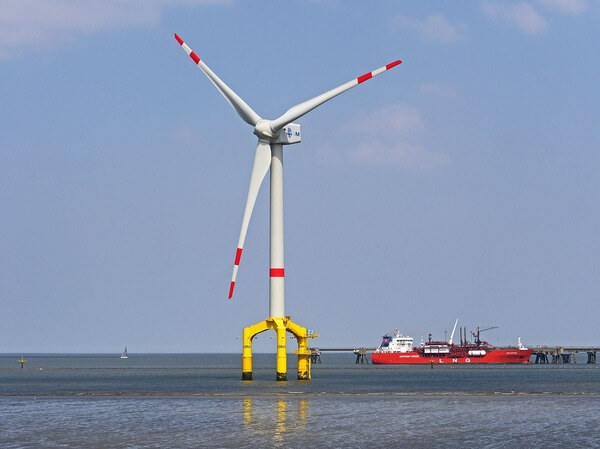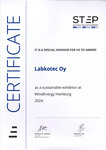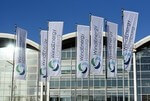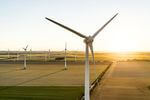News Release from windfair.net
Wind Industry Profile of
WindEnergy Hamburg 2020 - An Outlook
WindEnergy 2020 will be different - in many ways. This was already noticeable at the press conference, which this year for the first time was held virtually. Nevertheless, Bernd Aufderheide of Hamburg Messe und Congress GmbH had assembled a panel of experts to jointly give an outlook on the show and the current situation of wind industry in times of the pandemic.
The WindEnergy 2020 trade fair and conference will be held in Hamburg from 1 to 4 December 2020, but in times of COVID-19 it is necessary to fundamentally change the concept. This year virtual content will be used on a large scale for the first time. This had been in the planning stage for some time and has now been pushed forward due to the restrictions.
Nevertheless, more than 90 percent of the exhibitors have so far agreed to continue to be present at the show itself, including the major turbine manufacturers and other major exhibitors. In addition to 'social distancing', the exhibition area will be increased, as trade fair boss Aufderheide explained. At the moment, his company is in contact with other organizers to exchange information about opportunities. There will be an elaborated security concept ready by August, "various things are being planned, such as the fresh air supply".
What is clear is that thematically, the fight against climate change will play a major role, since one instrument for combating it is the energy transition. But new topics such as the use of hydrogen in combination with wind energy will also be in the focus.
Asked about the current situation of the European wind industry in times of COVID-19, WindEurope CEO Giles Dickson explained that maintenance and service work is continuing almost unabated despite the virus, though there have been problems with supply chains and logistics in production. The European association thus expects that in 2020 a total of 30 percent fewer wind turbines will be installed than the 18 gigawatts originally planned. "We are now expecting an increase of 12 gigawatts and hope that many of the postponed projects can be realized next year," said Dickson.
The situation on the international market is similar. Ben Backwell of the Global Wind Energy Council (GWEC) estimated that there will be 16 to 20 percent fewer installations than the originally planned 76 gigawatts. "2020 was actually supposed to be a record year for the wind industry," Backwell regretted.
Nevertheless, all participants agreed that the renewable energy industry as a whole has hardly been affected by the pandemic. "In recent months, Germany has continuously had a share of more than 50 percent of renewable energies in the grid. And there have been no problems with the power supply. So it's working," stressed Thorsten Herdan, who is responsible for energy policy in the Federal Ministry of Economics in Germany. Afterwards he promoted the renewed Wind Energy at Sea Act passed yesterday, which puts Germany's offshore plans on a higher level.
He also explained how things should continue at the political level. During the crisis, he said, all the money had first been paid out to everyone, but now the focus is shifting to reconstruction and with it the European Union's Green Deal. The EU wants a "green recovery" with money distributed to promising industries. Fossil fuel industry will therefore probably be left out.
"COVID-19 is a severe blow to EU's domestic economy. Last week the EU reconstruction plan explicitly mentioned wind energy and other renewable energy sources as part of the political foundation for reconstruction. And wind energy will deliver. It is cheap, reliable and already covers 15% of Europe's electricity consumption. The EU wants to increase this to 50 percent by 2050. That means gigantic investments. It means that investments must be made now. That will bring jobs and the growth we need now. The EU is mobilising its entire financial arsenal to support green reconstruction - 1.85 trillion euros. WindEnergy Hamburg in December will show how wind energy can score here," said Giles Dickson.

Corona has changed the way we work offshore, says Markus Tacke from Siemens Gamesa (Image: Pixabay)
Markus Tacke, CEO of turbine manufacturer Siemens Gamesa, provided insights into how companies in the industry have been affected by the pandemic. First of all, he said, employees were sent to their home offices wherever possible and a task force developed ideas and possibilities for future work. All in all, he said, his company had surprisingly few problems in logistics, while it became more critical where people were directly involved. Although the factories haven't experienced any failures so far, cooperation has changed. As an example, he cited offshore service ships crews, whose working periods have been extended from two weeks to four to six weeks at sea. In addition, there are many tests and the quarantines for the relevant employees.
But Tacke also looked ahead and emphasized that he didn't see any long-term effects of the pandemic on wind industry. At the moment there were short-term problems in need to be tackled and solved. Problems were more likely to be caused by politics, said Giles - like long-term permitting rounds and little acceptance for wind power. This has to be worked on worldwide. Thus wind industry can make a significant contribution to recovery and reconstruction as well as the decarbonisation of the world. For this reason, sector coupling will play an important role at Wind Energy 2020 again.
Heavily battered wind industry could thus emerge from this crisis as one of the big winners. At least it has shown already that a world with renewables is possible.
- Author:
- Katrin Radtke
- Email:
- press@windfair.net
- Keywords:
- WindEnergy 2020, Hamburg, Germany, trade fair, WindEurope, GWEC, Siemens Gamesa, Hamburg Messe und Congress, conference, optimism, COVID-19, corona, EU, recovery, Green Deal
























